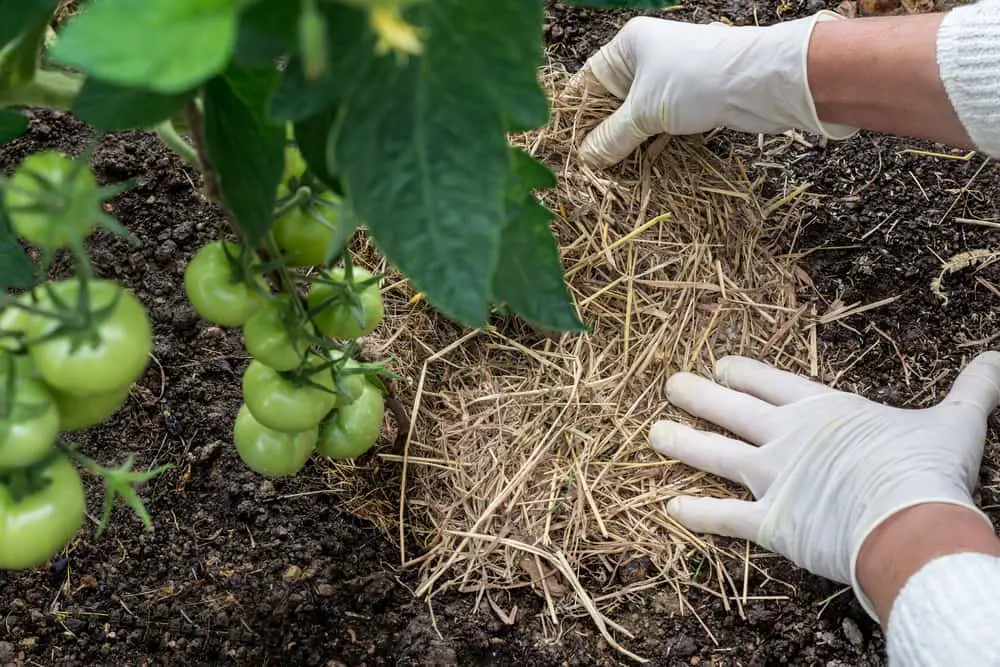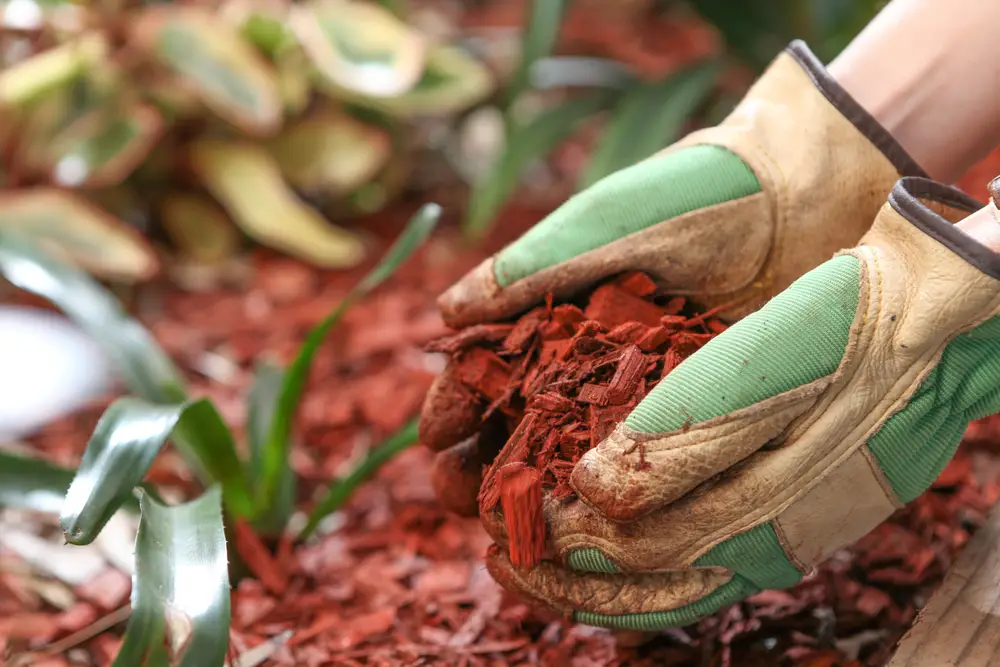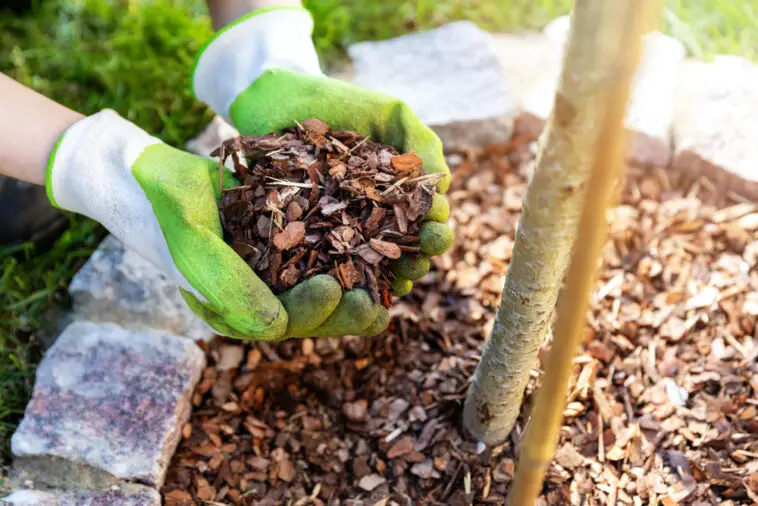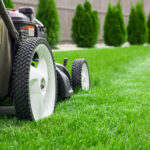For any avid gardener, you’re used to using mulch in your garden or flower bed year round. Mulch effectively blocks weeds, prevents frost during heavy winters, and helps plant roots stay cool through hot summers.
Mulch’s main purpose is to retain moisture in the soil without drying it out, which is especially helpful for hot, dry summers.
When you think of mulch, you may think of shredded hardwood chips or dirt. Technically, mulch is any material spread over the soil surface over a plant bed. This could be pine needles, shredded bark, newspaper, dry fall leaves, straw, and hay.
But what to do with old mulch in your garden? After a long winter or summer, the mulch may be too wet or too dry to reuse over the soil. Luckily, there are some creative ways to reuse old mulch and give it another use around your yard. Read on for three creative ideas on what to do with old mulch.
Types of Mulch
Organic Mulch

Natural organic mulch is often the preferred choice for vegetable gardens and those looking for a natural, non-synthetic material in their garden bed. Organic material can add essential nutrients to growing plants. The disadvantage of organic mulch is that it is not as effective to suppress weeds.
Inorganic Mulch
On the other hand, inorganic mulch is the best way to block weeds in your garden. It doesn’t provide any nutrients to the soil, but it does last longer. You can reuse it for longer, and it retains water better than organic mulch. Inorganic mulch is made of materials like plastic, fabric, gravel, and stone.
Can I Still Use Old Mulch?
Old mulch can still be good to use, depending on its condition. Take a look at the state of the mulch. Has much of it decomposed? Does it appear rotting or very damp? If it doesn’t seem significantly decomposed, it will still be good to use for your garden beds and soil.
Old mulch that has become rotten will show signs of infestation and infection. If the mulch is covered in pests and ants or breaks apart when you handle it, get rid of the mulch from your soil, as it may just end up causing problems. The best removal method is to rake up the mulch, break it apart from any matting and sticking to the soil underneath, bag it up, and remove it from your yard.
Can I Reuse Mulch?

Mulch can be reused, depending on its condition. After a harsh winter or spring, mulch absorbs much of the dampness from heavy snow and precipitation. Do not reuse damp mulch, as it may contain fungi and rot, which you don’t want to spread to plants or trees in your garden.
You can reuse old mulch by loosening and fluffing it up. Turning over old mulch is the easiest way to reuse it, loosening the mulch layer.
After sitting for a few years, the mulch can develop a hard layer from condensation, so make a habit of fluffing up mulch at the beginning of the spring or summer. If it needs it, add a fresh mulch on top. About one to four inches should be enough to cover the soil bed.
What to Do With Old Mulch
If it looks like the mulch has decomposed to the point that it can’t be reused in your garden, an easy way to get rid of it is by adding it to the soil as compost.
Don’t throw old mulch in the garbage just yet! You can do a few handy and creative things with old mulch that doesn’t require too much effort. If you like to tend to your garden with a green thumb, here are some easy ideas for using old mulch.
1. Mix old mulch into the soil
Old organic mulch can easily be integrated into the soil through its natural decomposition. Mix whatever mulch is leftover from the previous season into the soil bed, ensuring that it is fully integrated into the soil. You’ll want to work on this and remove any excess mulch, as too much nitrogen in the soil will stunt plant growth.
However, if the mulch has already decomposed quite a bit, it should be easy to integrate it into the soil.
2. Compost old mulch
If you have a large garden bed, composting old mulch takes a bit of elbow grease. Rake up the old mulch, move it to a compost bag, and dispose of it properly. Upcycle your old mulch layer by turning it into compost to make fertilizer for your garden or to add to your at-home backyard compost.
If you don’t have compost at home, put the mulch in a compostable bag and bring it to your local municipal waste facility to dispose of it.
3. Reuse inorganic mulch
If you can’t use inorganic mulch in your garden bed anymore, it can be used for other purposes. Rake up the old inorganic mulch and collect it in a basket. For stone or gravel mulch, you can use it as a base for potted plants before inserting the soil. Plastic mulch can be reused and laid where you don’t want weeds to grow, such as under your patio or at the base of your home or shed.
How Often to Replace Mulch
You should replace mulch in your garden generally every one to two years. However, if you notice that the mulch is rotted, infested with pests, very damp, or not covering the soil enough, it’s time to replace the mulch.
If there was a particularly harsh winter or very dry summer, the mulch in your yard may have depreciated over time. Check in throughout the seasons to see how your garden bed, the soil, and the mulch are holding up. If the existing mulch layer is not adequately covering the soil, it may be time to replace it.
When to Throw Out Mulch
If you’ve got a lot of mulch that’s extremely damp or infected with pests, chances are it’s infected. This could be from old age or the previous season’s plants growing in the garden. To avoid future infestations, removing this mulch as soon as possible from your yard is best.
Infected mulch can still be composted depending on its chemical contents. If you’ve previously treated your garden bed or mulch with harsh chemicals, it may not be accepted by your local compost and should go in the regular waste bin. Most of the time, however, mulch can be composted.
Conclusion
Mulch is essential to your garden or flower bed, as it retains that essential soil moisture without drying or dampening your plants. To create a healthy bed of growing plants, keep your mulch in its best shape by fluffing it up at the beginning of the season and watering it as needed.
If the mulch in your yard looks about done, it’s best to get rid of it and use it elsewhere. It can be reincorporated into the soil, upcycled through composting, or reused in other spots in your yard.
Remember that if you’ve got old mulch, it’s best to dispose of it appropriately and not reuse it in the same soil bed. Using the same old mulch can attract pests, cause matting, and encourage diseases and weeds to spread to the rest of the garden.
Giving your garden extra love and care can go a long way in the end. A well-tended garden can encourage happy plant growth without worrying about pests, weeds, and infection. Regularly check on the soil bed in your garden, and replace the mulch every one to two years.






